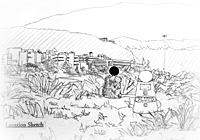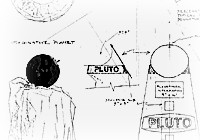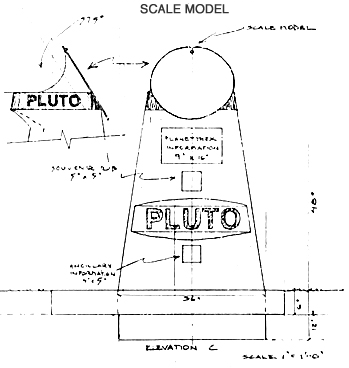Six planets were known in Earth's sky in 1801, when the Sicilian monk Giuseppe Piazzi, using the finest instrument of his day, discovered something new moving across the sky. It was right where the Titius-Bode law predicted a planet would be, so his discovery was naturally hailed as the seventh planet. He named it "Ceres Ferdinandea" after the Roman goddess of grains, and his sovereign, King Ferdinand IV. But soon many more objects were found there; several hundred were discovered by the end of that century, as well as giant Neptune, in 1846. Ceres's status as the new planet was short-lived. Giuseppe Piazzi had not discovered a new planet; he had discovered a bright member of the main asteroid belt, a collection of pieces that might have become a planet were it not for Jupiter's gravitation. It is difficult to see worlds that orbit the Sun near Neptune and beyond, so Clyde Tombaugh's celebrated discovery in 1930 was a welcome conclusion to his dedicated search for a ninth planet. Unlike Piazzi's planet, Pluto kept its title for many years. As instrumentation and techniques improved over the decades, astronomers would come to recognize that Tombaugh's distant icy object was a bright member of another belt of many objects — the Kuiper Belt, which, like the asteroid belt, contains remnants from the Solar System's formation. Using finest instruments of our day, dozens more Pluto-like worlds began to be discovered. The "tenth planet" Eris, discovered in 2003, was soon joined by discoveries of dozens more icy bodies beyond Neptune. Pluto and its neighbors were now to be seen as part of a vast belt. Just as Ceres became known as one of many objects in the asteroid belt, Pluto, and Eris and all their cousins — over a thousand are now known — are part of the Kuiper Belt. Pluto, Eris, and others are now known as "dwarf planets," as is Ceres, according to the International Astronomy Union's definition. The Planet Trek "Beyond Pluto" site stands as a glistening, shining monument to the icy realm of all the newly discovered worlds beyond Neptune. Those icy worlds are difficult to reach with a spacecraft. So Planet Trek's "Beyond Pluto" site is a little more difficult to get to than the rest, requiring a short hike, bike, equestrian, or wheelchair ride in Pasadena's Hahamongna Watershed Park. The Caltech/NASA Jet Propulsion Laboratory, where planetary missions are navigated (including the New Horizons spacecraft en route to Pluto and the Kuiper Belt) is visible in the background. The Imaginative Sculpture, much larger than the scale object, is designed to catch a bright sun reflection and capture attention from afar, as well as to convey some aspects of these cold worlds. It consists of an 18-inch diameter sphere of highly polished stainless steel set atop a boulder.
The Imaginative Sculpture's appearance is intended to be reflective of the cold and unknown nature of the many worlds beyond Neptune. The base is an Imperial Black granite boulder. Approximate height with sphere is 4 feet 6 inches. The sphere is fixed to its boulder base, and the base is attached to footing at the ground. The Scale Model is part of a unique orbital disk depicting Pluto's equatorial plane, highly inclined, and the scale model dwarf planet on the angle of its polar axis. The base supporting the Scale Model is a pre-cast, uniquely finished concrete pedestal, with informational insets and a title plaque in stainless steel, copper or brass, with etched enamel infill. The information included will place Pluto in context within the greater Kuiper Belt, and will explain its "dwarf planet" status. Both the Scale Model and the Imaginative Sculpture are on concrete footings connected by a concrete arc with brass inset directional arrows and the dwarf planet's name. Ten "Great Question" plaques surround this site, as with all the other sites, set at ground level.
The detail at right illustrates the scale Pluto model on a metal surface angled about 122 degrees from level (about 58 degrees measured on the other side) to represent the dwarf planet's natural equatorial tilt. The scale dwarf planet is a bump on this plate only about 0.058 inch in diameter, its true scale size compared to the three-foot diameter Sun which is about 12,750 feet away. This rests atop a concrete pedestal with information and name plaques. Also present on the pedestal is a unique souvenir rub-transfer icon which may be used in school projects and promotional activities to provide evidence of visit. Since the Pluto site is in view of JPL, an information plaque tells about JPL's role in solar system exploration.
RETURN TO THE SUN SITE
|



